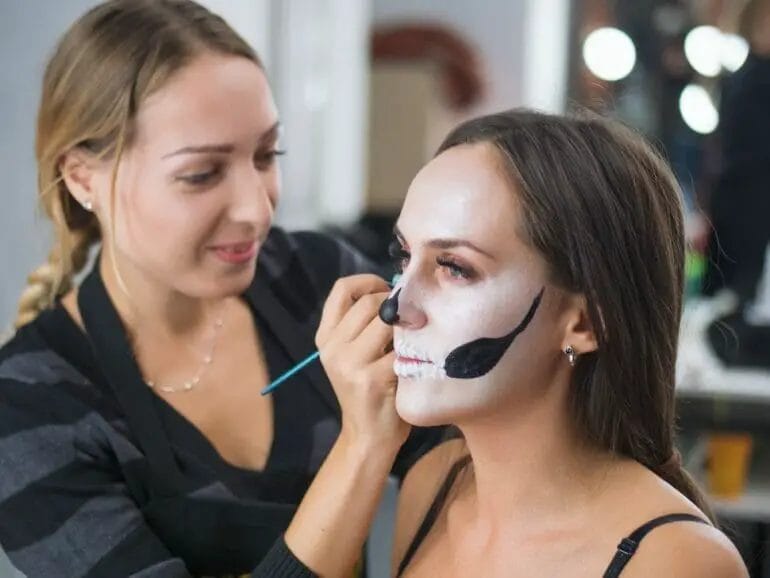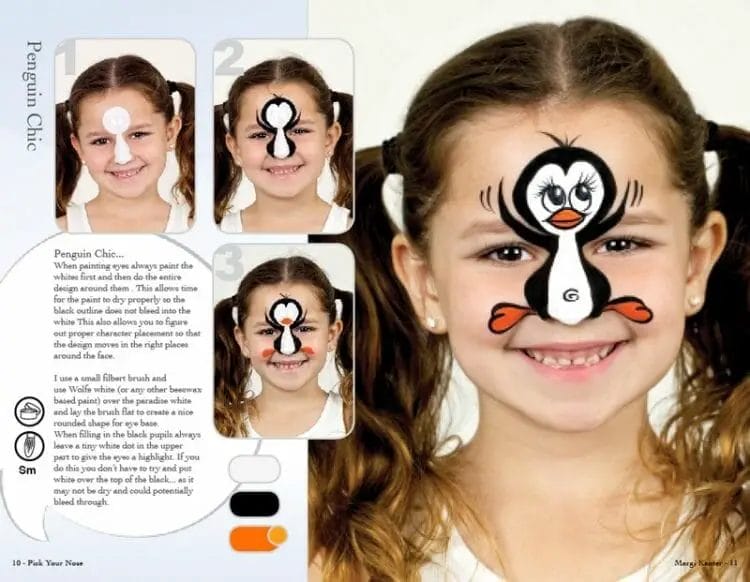Yes, face paint does dry. Face paint is a type of cosmetic product specifically designed to be used on the skin. It typically contains ingredients that allow it to dry quickly upon application. Once dry, face paint creates a smooth, vibrant, and long-lasting design on the face. The drying time may vary depending on the brand and formula of the face paint, but in general, it dries within a few minutes.

Tips to Speed Up the Drying Process of Face Paint
Face painting is a fun and creative activity that allows you to transform your face into a work of art. Whether you’re getting ready for a costume party, a cosplay event, or a children’s birthday party, applying face paint can be an exciting experience. However, waiting for the paint to dry can sometimes be a bit of a hassle. To help you speed up the drying process, we have gathered some useful tips and techniques that will have your face paint set in no time.
1. Use Thin Layers
One of the easiest ways to speed up the drying process of face paint is to apply thin layers. Using thick layers of paint can take longer to dry and may result in a smudged or streaky finish. Instead, use a small brush or sponge to apply thin coats of paint. Allow each layer to dry completely before applying the next one. This will help the paint dry faster and ensure a smooth and even application.
2. Use Water-Based Face Paint
Choosing the right type of face paint can also significantly impact the drying time. Opt for water-based face paints that are specifically formulated for use on the skin. These paints dry much faster compared to oil-based or cream-based paints. They are also easier to remove and less likely to cause skin irritation. Look for reputable brands that are known for their quality and safety standards.
3. Set the Paint with Setting Powder
After applying the face paint, you can use setting powder to help speed up the drying process. Setting powder is a fine translucent powder that can be applied over the face paint to lock it in place. Use a fluffy brush to gently dust the powder over your design. The powder will absorb any excess moisture and help the paint dry faster. It will also help prevent smudging and prolong the lifespan of your face paint.
4. Use a Hairdryer on a Cool Setting
If you’re in a hurry and need your face paint to dry quickly, you can use a hairdryer on a cool setting. Hold the hairdryer at least 12 inches away from your face and use the cool air setting to gently blow-dry the paint. Be careful not to use heat as it can cause the paint to melt or smudge. Keep the hairdryer at a safe distance and move it around to evenly distribute the cool air.
5. Avoid Excessive Moisture
Excessive moisture can prolong the drying time of face paint. Avoid direct contact with water or excessive sweating while the paint is still wet. Try to keep your face as dry as possible during the drying process. If you need to cool down, use a fan or stand in front of a gentle breeze. This will help evaporate any moisture and speed up the drying time.
6. Use a Setting Spray
Another effective way to speed up the drying process of face paint is to use a setting spray. Setting sprays are specially formulated to lock in makeup and help it set faster. After applying the face paint, hold the setting spray about 12 inches away from your face and mist it lightly over the painted area. The spray will help the paint dry faster and provide a protective barrier against smudging or fading.
7. Allow Sufficient Drying Time
While it’s important to speed up the drying process, it’s equally crucial to allow sufficient drying time for the face paint to set properly. Rushing the drying process can result in a compromised finish and may cause the paint to crack or peel. Follow the instructions provided by the manufacturer and give the paint enough time to dry before touching or applying any additional layers.
Final Thoughts
In summary, there are several effective ways to speed up the drying process of face paint. By using thin layers, opting for water-based paint, setting the paint with powder, using a hairdryer on a cool setting, avoiding excessive moisture, and using a setting spray, you can significantly reduce the drying time. Remember to give the paint sufficient drying time to ensure a long-lasting and flawless finish. With these tips and techniques, you’ll be able to enjoy your beautifully painted face in no time.

The Importance of Allowing Face Paint to Fully Dry
Face painting is a popular activity at parties, festivals, and other events. It allows people of all ages to transform themselves into their favorite characters, animals, or designs. However, one crucial step that is often overlooked is allowing the face paint to fully dry.
When face paint is applied, it initially appears wet and shiny. This is because the paint contains water and other ingredients that help it adhere to the skin. While it may be tempting to move on to the next step or touch the painted area, it is essential to exercise patience and wait for the paint to dry completely.
There are several reasons why allowing face paint to fully dry is crucial:
1. Prevent Smudging and Smearing
When face paint is still wet, it is susceptible to smudging and smearing. Touching or rubbing the painted area can cause the design to lose its crispness and clarity. This can be especially disappointing if you have spent time and effort creating an intricate and detailed design on someone’s face.
By allowing the face paint to dry completely, you minimize the risk of accidental smudging or smearing. The paint will adhere firmly to the skin, ensuring that your design stays intact throughout the event.
2. Avoid Transferring the Paint
Wet face paint can easily transfer onto clothing, costumes, or other surfaces that come into contact with it. This can lead to stains and undesirable marks. Additionally, if the painted area comes in contact with other parts of the face or body, it can create unintentional smudges and mess up the overall look.
By giving the face paint enough time to dry, you significantly reduce the chances of transferring the paint onto unintended surfaces. This helps to maintain the cleanliness of costumes, props, and other elements of the event.
3. Enhance Longevity
One of the primary reasons people opt for face painting is to enjoy the design throughout the duration of the event. Whether it’s a few hours or an entire day, it’s important to ensure that the face paint lasts as long as possible.
Allowing the face paint to fully dry can enhance its longevity. Once dry, the paint forms a protective layer on the skin, making it less susceptible to wear and tear caused by sweat, rubbing, or external factors. This means that your face paint will stay vibrant and intact for an extended period.
4. Promote Skin Safety
Face paint is applied directly to the skin, and improper drying can have adverse effects on the wearer’s skin. When the paint is still wet, it can clog pores, leading to skin irritation, breakouts, or allergic reactions. Additionally, wet face paint may contain bacteria or other contaminants that can cause skin infections.
By allowing the face paint to dry thoroughly before interacting with it, you minimize the risk of skin issues. Dry face paint is less likely to clog pores or cause irritation, ensuring a safer and more enjoyable face painting experience.
In Summary
Allowing face paint to fully dry is a crucial step in the face painting process. It helps prevent smudging and smearing, avoids transferring the paint onto unintended surfaces, enhances the longevity of the design, and promotes skin safety.
By practicing patience and allowing the face paint to dry completely, you can ensure that your face painting creations remain vibrant and intact, providing a memorable experience for both the wearer and the observer.

Understanding the Factors That Affect Face Paint Drying Time
Face painting is a popular activity at parties, festivals, and events. Whether you are a professional face painter or simply enjoying a fun DIY project at home, understanding the factors that affect face paint drying time is essential. This knowledge will help you achieve the best results and ensure that your designs last longer.
1. Type of Face Paint
The type of face paint you use plays a significant role in its drying time. There are two main types of face paint: water-based and oil-based. Water-based face paints dry relatively quickly, usually within a few minutes. On the other hand, oil-based face paints, which are more durable and waterproof, take longer to dry, usually around 10-15 minutes.
It’s important to consider the type of face paint you use based on your specific needs. If you require a quick drying time, opt for water-based face paints. If you need longer-lasting designs, oil-based face paints may be a better choice.
2. Application Technique
The way you apply the face paint can also affect its drying time. If you apply a thick layer of paint, it will take longer to dry compared to a thin layer. It’s recommended to use thin layers of face paint to ensure quicker drying. Additionally, spreading the paint evenly and avoiding excess moisture can help speed up the drying process.
Consider using a sponge or brush for application, as these tools allow for more control and even coverage. Avoid using your fingers, as they can transfer oils and moisture to the face paint, thereby prolonging the drying time.
3. Humidity and Temperature
The environmental conditions, such as humidity and temperature, can significantly influence the drying time of face paint. High humidity levels can slow down drying, while low humidity levels can speed it up. Similarly, warmer temperatures tend to accelerate drying, whereas colder temperatures can delay it.
When face painting, try to work in a well-ventilated area with moderate humidity levels and a comfortable temperature. Avoid painting in extremely humid or cold conditions, as these may impede the drying process and affect the final result.
4. Thickness of Design
The thickness of your face paint design can also impact its drying time. Intricate designs with multiple layers of paint or thicker strokes will naturally take longer to dry compared to simpler designs with thinner lines.
If you are creating complex designs, it’s essential to allow sufficient drying time between layers to prevent smudging or smearing. Consider using a hairdryer on a low, cool setting to speed up the drying process between layers, but be cautious not to apply heat too close to the skin.
5. Setting Powder
Using a setting powder can help enhance the longevity of your face paint and reduce drying time. After applying the face paint, gently dust a thin layer of setting powder over the design using a brush. The setting powder absorbs excess moisture, allowing the paint to dry more quickly and preventing smudging.
Ensure that the face paint is completely dry before applying the setting powder to avoid clumping or smearing. You can also use a makeup setting spray as an alternative to setting powder for additional durability and quicker drying.
Summary
Understanding the factors that affect face paint drying time is essential for achieving successful and long-lasting designs. The type of face paint, application technique, humidity and temperature, thickness of the design, and the use of setting powder all contribute to the overall drying time.
By considering these factors and making appropriate adjustments, you can ensure that your face paint dries quickly and provides beautiful results that will last throughout the event.
How to Ensure Face Paint Dries Quickly and Lasts Longer
Face painting is a fun and creative way to express yourself and add some excitement to parties, events, or even just a casual day out. However, one common challenge faced by face painters is ensuring that the paint dries quickly and lasts longer on the face. In this section, we will explore some tips and tricks to help you achieve this.
1. Start with a Clean, Dry Face
Before applying face paint, it’s important to ensure that the face is clean and dry. Any oils, dirt, or moisturizers on the skin can prevent the paint from adhering properly and cause it to smudge or fade quickly. Cleanse the face using a gentle cleanser and pat it dry with a towel before starting the face painting process.
2. Use a Primer
Using a primer before applying the face paint can create a smooth surface for the paint to adhere to. It helps to create a barrier between the skin and the paint, ensuring better longevity and preventing the colors from being absorbed into the skin. Apply a thin layer of face paint primer and allow it to dry completely before moving on to the next step.
3. Set the Face Paint with Setting Powder
After applying the face paint, it’s important to set it with a setting powder to lock it in place and prevent smudging. Gently dust a translucent setting powder over the painted areas using a soft brush or a powder puff. This helps absorb any excess moisture and ensures that the paint stays in place for a longer period.
4. Use Quality Face Paint Products
The quality of the face paint products you use plays a significant role in how long the paint lasts on the face. Invest in high-quality, water-based face paints that are specifically formulated for use on the skin. These paints are usually non-toxic, easy to apply, and dry quickly. They also tend to have better staying power compared to low-quality paints.
5. Avoid Excessive Moisture
Avoid exposing the face to excessive moisture, as it can cause the face paint to smudge or fade. Advise the person with the face paint to avoid touching their face excessively or rubbing the painted areas. Additionally, if it’s a hot and humid day, consider incorporating a makeup setting spray into the face painting routine to provide an extra layer of protection.
6. Allow Sufficient Drying Time
When face painting, it’s crucial to allow sufficient drying time between layers or different colors. Applying the next layer or color too quickly can cause the paints to blend together or smear. Patience is key to achieving vibrant and long-lasting face paint designs.
7. Avoid Face Paints near Oily Areas
Avoid applying face paints directly to areas that tend to be naturally oily, such as the T-zone or areas prone to sweating. Instead, focus on other areas of the face that are less prone to oiliness. This helps prevent the paint from sliding off due to excess oil, ensuring better longevity.
8. Remind the Person to Avoid Touching the Face
Finally, remind the person with the face paint to avoid touching or rubbing their face unnecessarily. Constant touching can smudge the paint and shorten its lifespan. Encourage them to be mindful and avoid any activities that may cause the paint to come off prematurely.
In summary, ensuring that face paint dries quickly and lasts longer requires proper preparation, the use of quality products, and taking precautions to avoid smudging. Cleanse and prime the face, set the paint with a setting powder, use high-quality face paint products, avoid excessive moisture, allow sufficient drying time, avoid oily areas, and remind the person to avoid touching their face unnecessarily. By following these tips, you can create stunning face paint designs that will stay vibrant throughout the event or party.
FAQs
Does face paint dry?
Yes, face paint typically dries on the skin. The drying time can vary depending on the brand and type of face paint used, but it generally takes a few minutes to dry completely.
Conclusion
In conclusion, face paint does indeed dry. Whether you are using water-based or oil-based face paint, both types will dry on the skin, creating a resistant and long-lasting effect. The drying time may vary depending on the type and brand of face paint you are using, as well as the application technique. It is important to allow the face paint to completely dry before touching or rubbing it to prevent smudging or smearing. Once the face paint is dry, you can enjoy the vibrant colors and designs throughout your event or celebration.
